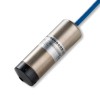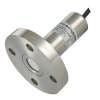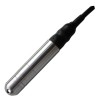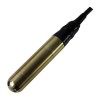Absolute unvented reference hydrostatic level sensors provide reliable liquid level measurement in challenging environments where traditional vented sensors are impractical. These sensors, with their fixed pressure reference, are particularly well-suited for applications such as underwater vessels, sealed tanks, and remote monitoring situations where a vent tube cannot be easily accommodated.
 LMK458 Marine Approved Hydrostatic Level Transmitter - Marine approved level transmitter with 4-20mA output for measuring level of contents inside ship ballast, fuel, liquid cargo or wastewater tanks
LMK458 Marine Approved Hydrostatic Level Transmitter - Marine approved level transmitter with 4-20mA output for measuring level of contents inside ship ballast, fuel, liquid cargo or wastewater tanks LMK457 Marine Approved Level Transmitter - Marine approved level transmitter with 4-20mA current loop output for shipbuilding with optional all CuNiFe construction for sea-water compatibility in ranges from 0.4 mH2O to 250mH2O gauge.
LMK457 Marine Approved Level Transmitter - Marine approved level transmitter with 4-20mA current loop output for shipbuilding with optional all CuNiFe construction for sea-water compatibility in ranges from 0.4 mH2O to 250mH2O gauge. S12C SDI-12 Seawater Pressure & Temperature Transducer - SDI-12 protocol transducer for sensing water depth level and temperature in seawater, brackish water, tidal water, saline water or leachate.
S12C SDI-12 Seawater Pressure & Temperature Transducer - SDI-12 protocol transducer for sensing water depth level and temperature in seawater, brackish water, tidal water, saline water or leachate. S12S SDI-12 Coms IP68 Pressure and Temperature Sensor - Combined pressure and temperature sensor with a 1200 baud rate serial data interface as defined by the SDI-12 support group.
S12S SDI-12 Coms IP68 Pressure and Temperature Sensor - Combined pressure and temperature sensor with a 1200 baud rate serial data interface as defined by the SDI-12 support group. SWL Marine Bronze Submersible Level Sensor - Analogue output sensor for immersing in seawater to determine depth or change in water level by measuring hydrostatic pressure.
SWL Marine Bronze Submersible Level Sensor - Analogue output sensor for immersing in seawater to determine depth or change in water level by measuring hydrostatic pressure. IMCTL Submersible Liquid Level and Temperature Transmitter - IP68 combined liquid level and temperature, dual 4 to 20 milliamp output pressure sensor with a 316L or Marine Bronze housing.
IMCTL Submersible Liquid Level and Temperature Transmitter - IP68 combined liquid level and temperature, dual 4 to 20 milliamp output pressure sensor with a 316L or Marine Bronze housing. IMCL Submersible Absolute Reference Depth Sensor - Absolute reference hydrostatic depth sensor with an IP68 sealed electrical interface, SS316L, Duplex or PVC housing and a mV, voltage or current output.
IMCL Submersible Absolute Reference Depth Sensor - Absolute reference hydrostatic depth sensor with an IP68 sealed electrical interface, SS316L, Duplex or PVC housing and a mV, voltage or current output. IMCL Low Cost Submersible Pressure Sensor - Economical IP68 protected sensor with stainless steel 316L housing and Ceramic strain gauge sensing diaphragm for measuring liquid depth pressure.
IMCL Low Cost Submersible Pressure Sensor - Economical IP68 protected sensor with stainless steel 316L housing and Ceramic strain gauge sensing diaphragm for measuring liquid depth pressure. IMSL IP68 Stainless Steel 316L Hydrostatic Pressure Sensor - Water resistant pressure sensor for measuring hydrostatic pressures in the range of 0-0.5 mWC up to 0-100 mWC.
IMSL IP68 Stainless Steel 316L Hydrostatic Pressure Sensor - Water resistant pressure sensor for measuring hydrostatic pressures in the range of 0-0.5 mWC up to 0-100 mWC. IWSL Potable Water Submersible Level Sensor - IP68 protect pressure sensor for monitoring potable water level to depths of 100 metres.
IWSL Potable Water Submersible Level Sensor - IP68 protect pressure sensor for monitoring potable water level to depths of 100 metres. IMSTL IP68 Water Temperature and Depth Transmitter - Stainless steel 316L waterproof probe for measuring both water temperature and depth and generating two separate 4-20mA current loop measurement signals.
IMSTL IP68 Water Temperature and Depth Transmitter - Stainless steel 316L waterproof probe for measuring both water temperature and depth and generating two separate 4-20mA current loop measurement signals.
- BMS water tank 6mH2Og range 0-10V out submersible level sensor for commercial buildings
- SDI-12 interface, 2 bar absolute, submersible water level sensor
- Seawater depth sensor with I2C output for aquaculture underwater camera integration
- Sonde OEM water depth sensor for 300m deep borehole
- Non-vented submersible absolute range pressure and barometric sensor for measuring 10m water level
Find out more about Absolute Unvented Reference Hydrostatic Liquid Level Sensors to determine which product options and capabilities will best meet your application requirements.
Absolute unvented reference hydrostatic level sensors offer a specialized solution for liquid level measurement in situations where traditional vented sensors are not feasible. Unlike their vented counterparts, these sensors utilize a fixed pressure reference, making them ideal for applications where venting to the atmosphere is impractical or impossible.
Absolute unvented reference sensors operate on the principle of hydrostatic pressure. The sensor measures the pressure exerted by the liquid column above it, and this pressure is normally directly proportional to the liquid level for a vented reference sesnor. However, since these sensors lack an atmospheric pressure vent, the measured pressure is absolute, meaning it includes the ambient atmospheric pressure.
To ensure accurate level measurement, particularly in low-range depth applications, it’s essential to account for variations in barometric pressure. This can be achieved by incorporating a separate barometric pressure sensor into the system. The readings from the hydrostatic level sensor can then be adjusted based on the measured barometric pressure, providing a true and accurate representation of the liquid level.
Applications
- Underwater Vehicles and Submersibles: The sealed environment of underwater vessels makes it challenging to establish a vent tube to the surface for atmospheric pressure compensation. Absolute unvented reference sensors eliminate this need, providing accurate level measurements without the complexities of external venting.
- Sealed Tanks and Vessels: In industrial processes involving sealed tanks or vessels, maintaining the integrity of the contained environment is crucial. Unvented sensors allow for level measurement without compromising the seal, ensuring process safety and product quality.
- Remote Monitoring and Difficult-to-Access Locations: When sensors are deployed in remote or difficult-to-access locations, establishing a vent tube can be impractical or cost-prohibitive. Unvented sensors offer a self-contained solution, simplifying installation and maintenance in such scenarios.
